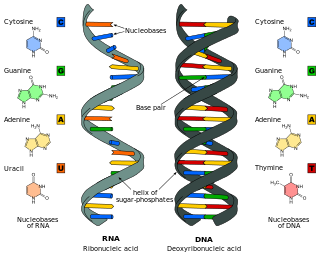 W
WIn evolutionary biology, abiogenesis, or informally the origin of life (OoL), is the natural process by which life has arisen from non-living matter, such as simple organic compounds. While the details of this process are still unknown, the prevailing scientific hypothesis is that the transition from non-living to living entities was not a single event, but an evolutionary process of increasing complexity that involved molecular self-replication, self-assembly, autocatalysis, and the emergence of cell membranes. Although the occurrence of abiogenesis is uncontroversial among scientists, its possible mechanisms are poorly understood. There are several principles and hypotheses for how abiogenesis could have occurred.
 W
WBotryosphaeran is an exopolysaccharide (EPS) produced by the ascomyceteous fungus Botryosphaeria rhodina. Characterization of the chemical structure of botryosphaeran showed this EPS to be a (1→3)(1→6)-β-D-glucan.This particular β-glucan can be produced by several strains of Botryosphaeria rhodina that include: MAMB-05, DABAC-P82, and RCYU 30101. Botryosphaeran exhibits interesting rheological properties and novel biological functions including hypoglycaemia, hypocholesterolaemia, anti-atheroslerosis and anti-cancer activity, with potential commercial applications. Three cosmetic products formulated with botryosphaeran have been developed to promote skin health and treat skin conditions for future intended commercialization purposes.
 W
WHemolithin is an iron and lithium-containing protein of extraterrestrial origin according to a preprint that has not been published in a scientific journal. It was purportedly found inside two CV3 meteorites, Allende and Acfer-086, by a team of scientists led by Harvard University biochemist Julie McGeoch. The report of the discovery was met with some skepticism and suggestions that the researchers had extrapolated too far from incomplete data.
 W
WJeewanu are synthetic chemical particles that possess cell-like structure and seem to have some functional properties; that is, they are a model of primitive cells, or protocells. It was first synthesised by Krishna Bahadur, an Indian chemist and his team in 1963. Using photochemical reaction, they produced coacervates, microscopic cell-like spheres from a mixture of simple organic and inorganic compounds. Bahadur named these particles 'Jeewanu' because they exhibit some of the basic properties of a cell, such as the presence of semipermeable membrane, amino acids, phospholipids and carbohydrates. Further, like living cells, they had several catalytic activities. Jeewanu are cited as models of protocells for the origin of life, and as artificial cells.
 W
WPanspermia is the hypothesis that life exists throughout the Universe, distributed by space dust, meteoroids, asteroids, comets, planetoids, and also by spacecraft carrying unintended contamination by microorganisms. Distribution may have occurred spanning galaxies, and so may not be restricted to the limited scale of solar systems.
 W
WPlanetary habitability is the measure of a planet's or a natural satellite's potential to develop and maintain environments hospitable to life. Life may be generated directly on a planet or satellite endogenously or be transferred to it from another body, through a hypothetical process known as panspermia. Environments do not need to contain life to be considered habitable nor are accepted habitable zones the only areas in which life might arise.
 W
WA protocell is a self-organized, endogenously ordered, spherical collection of lipids proposed as a stepping-stone toward the origin of life. A central question in evolution is how simple protocells first arose and how they could differ in reproductive output, thus enabling the accumulation of novel biological emergences over time, i.e. biological evolution. Although a functional protocell has not yet been achieved in a laboratory setting, the goal to understand the process appears well within reach.
 W
WThe RNA world is a hypothetical stage in the evolutionary history of life on Earth, in which self-replicating RNA molecules proliferated before the evolution of DNA and proteins. The term also refers to the hypothesis that posits the existence of this stage.
 W
WTholins are a wide variety of organic compounds formed by solar ultraviolet or cosmic rays irradiation of simple carbon-containing compounds such as carbon dioxide, methane or ethane, often in combination with nitrogen or water. Tholins are disordered polymer-like materials made of repeating chains of linked subunits and complex combinations of functional groups, typically nitriles and hydrocarbons and their degraded forms such as amines and phenyls. Tholins do not form naturally on modern-day Earth, but they are found in great abundance on the surfaces of icy bodies in the outer Solar System, and as reddish aerosols in the atmosphere of outer Solar System planets and moons.
 W
WIn planetary science, volatiles are the group of chemical elements and chemical compounds with low boiling points that are associated with a planet's or moon's crust or atmosphere. Examples include nitrogen, water, carbon dioxide, ammonia, hydrogen, methane and sulfur dioxide. In astrogeology, these compounds, in their solid state, often comprise large proportions of the crusts of moons and dwarf planets.